Research on Electric Vehicle Development: Annotated Bibliography
VerifiedAdded on 2023/06/03
|11
|3118
|213
Homework Assignment
AI Summary
This annotated bibliography examines the current developments in electric vehicles (EVs) and their role in creating a sustainable environment. It includes annotations of several journal articles that discuss the adoption of EVs, technological constraints, market potential, and the impact of EVs on reducing greenhouse gas emissions. The bibliography covers various aspects, such as consumer acceptance, the need for long-term energy storage solutions, the market for plug-in electric vehicles, challenges in implementing green supply chain management, the economics of using EV batteries for grid storage, and market penetration analysis. Furthermore, it delves into the concept of carsharing and its significance in sustainable transportation, as well as the role of electrochemical capacitors in hybrid vehicles. The bibliography emphasizes the importance of EVs in reducing reliance on fossil fuels, promoting energy efficiency, and fostering a greener ecosystem. It highlights the need for further research and innovation to overcome challenges and promote the widespread adoption of EVs.

Research and Enterprise 1
Research and Enterprise
Name
Institution Affiliation
State/city
Date
Research and Enterprise
Name
Institution Affiliation
State/city
Date
Paraphrase This Document
Need a fresh take? Get an instant paraphrase of this document with our AI Paraphraser
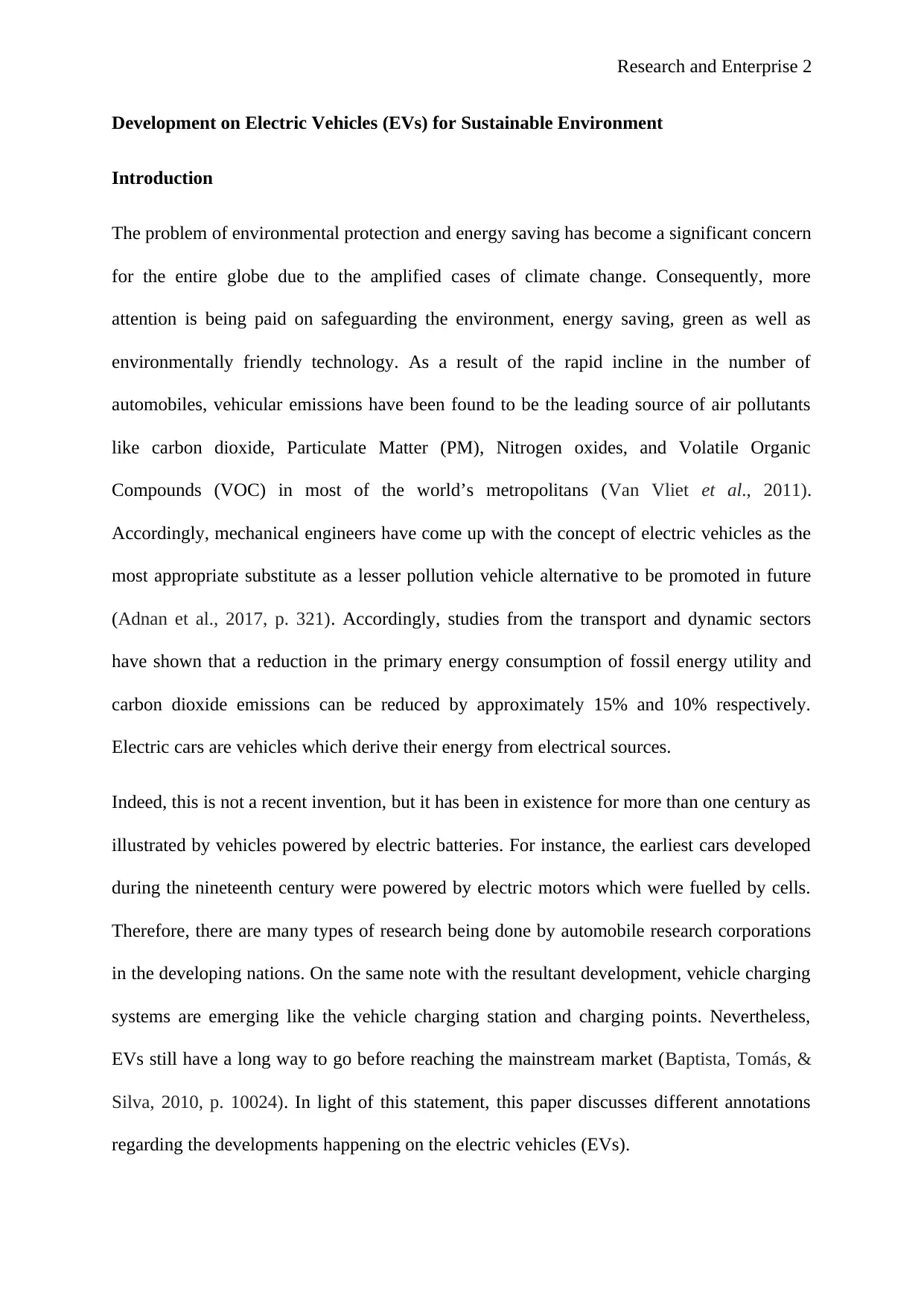
Research and Enterprise 2
Development on Electric Vehicles (EVs) for Sustainable Environment
Introduction
The problem of environmental protection and energy saving has become a significant concern
for the entire globe due to the amplified cases of climate change. Consequently, more
attention is being paid on safeguarding the environment, energy saving, green as well as
environmentally friendly technology. As a result of the rapid incline in the number of
automobiles, vehicular emissions have been found to be the leading source of air pollutants
like carbon dioxide, Particulate Matter (PM), Nitrogen oxides, and Volatile Organic
Compounds (VOC) in most of the world’s metropolitans (Van Vliet et al., 2011).
Accordingly, mechanical engineers have come up with the concept of electric vehicles as the
most appropriate substitute as a lesser pollution vehicle alternative to be promoted in future
(Adnan et al., 2017, p. 321). Accordingly, studies from the transport and dynamic sectors
have shown that a reduction in the primary energy consumption of fossil energy utility and
carbon dioxide emissions can be reduced by approximately 15% and 10% respectively.
Electric cars are vehicles which derive their energy from electrical sources.
Indeed, this is not a recent invention, but it has been in existence for more than one century as
illustrated by vehicles powered by electric batteries. For instance, the earliest cars developed
during the nineteenth century were powered by electric motors which were fuelled by cells.
Therefore, there are many types of research being done by automobile research corporations
in the developing nations. On the same note with the resultant development, vehicle charging
systems are emerging like the vehicle charging station and charging points. Nevertheless,
EVs still have a long way to go before reaching the mainstream market (Baptista, Tomás, &
Silva, 2010, p. 10024). In light of this statement, this paper discusses different annotations
regarding the developments happening on the electric vehicles (EVs).
Development on Electric Vehicles (EVs) for Sustainable Environment
Introduction
The problem of environmental protection and energy saving has become a significant concern
for the entire globe due to the amplified cases of climate change. Consequently, more
attention is being paid on safeguarding the environment, energy saving, green as well as
environmentally friendly technology. As a result of the rapid incline in the number of
automobiles, vehicular emissions have been found to be the leading source of air pollutants
like carbon dioxide, Particulate Matter (PM), Nitrogen oxides, and Volatile Organic
Compounds (VOC) in most of the world’s metropolitans (Van Vliet et al., 2011).
Accordingly, mechanical engineers have come up with the concept of electric vehicles as the
most appropriate substitute as a lesser pollution vehicle alternative to be promoted in future
(Adnan et al., 2017, p. 321). Accordingly, studies from the transport and dynamic sectors
have shown that a reduction in the primary energy consumption of fossil energy utility and
carbon dioxide emissions can be reduced by approximately 15% and 10% respectively.
Electric cars are vehicles which derive their energy from electrical sources.
Indeed, this is not a recent invention, but it has been in existence for more than one century as
illustrated by vehicles powered by electric batteries. For instance, the earliest cars developed
during the nineteenth century were powered by electric motors which were fuelled by cells.
Therefore, there are many types of research being done by automobile research corporations
in the developing nations. On the same note with the resultant development, vehicle charging
systems are emerging like the vehicle charging station and charging points. Nevertheless,
EVs still have a long way to go before reaching the mainstream market (Baptista, Tomás, &
Silva, 2010, p. 10024). In light of this statement, this paper discusses different annotations
regarding the developments happening on the electric vehicles (EVs).
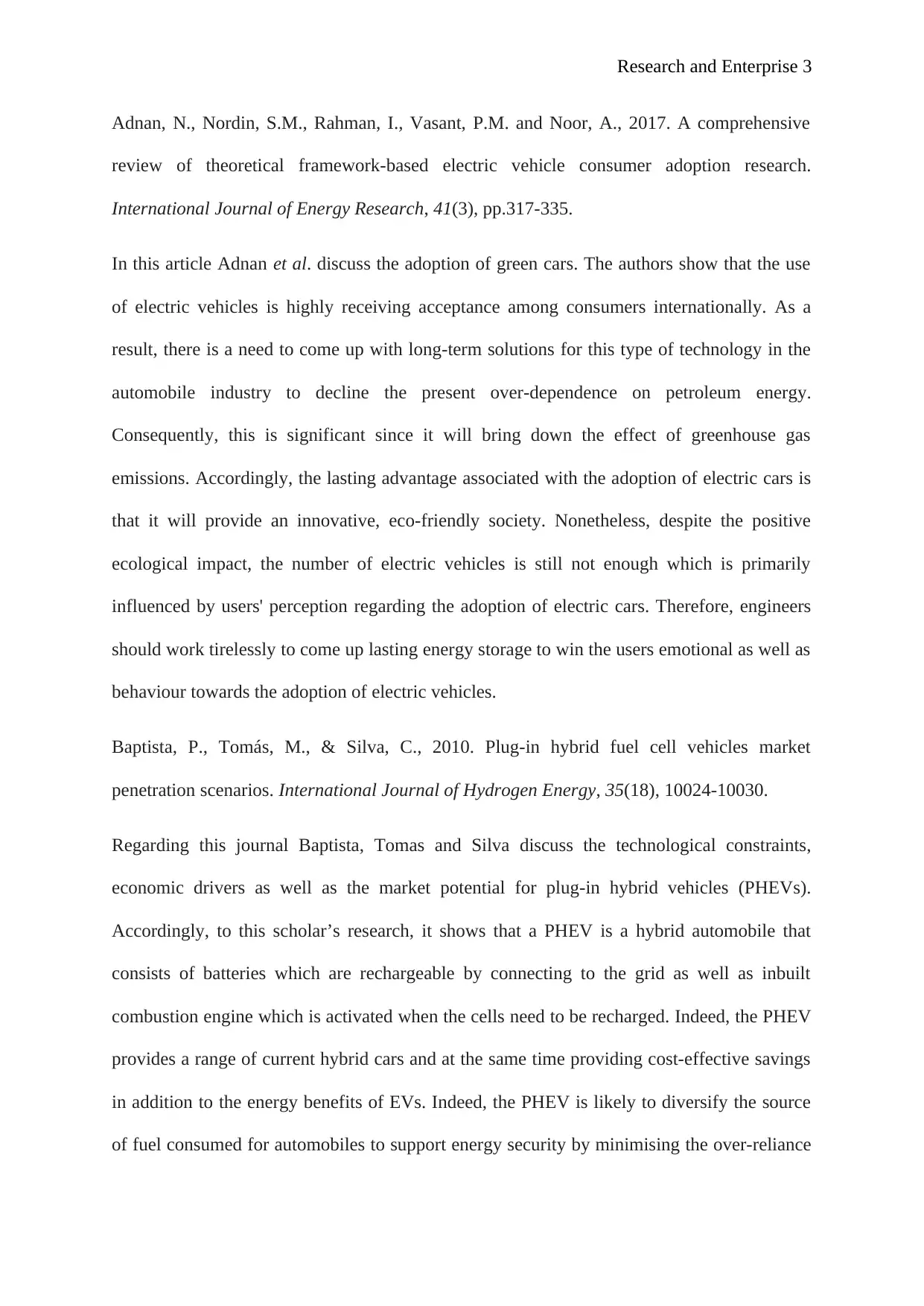
Research and Enterprise 3
Adnan, N., Nordin, S.M., Rahman, I., Vasant, P.M. and Noor, A., 2017. A comprehensive
review of theoretical framework‐based electric vehicle consumer adoption research.
International Journal of Energy Research, 41(3), pp.317-335.
In this article Adnan et al. discuss the adoption of green cars. The authors show that the use
of electric vehicles is highly receiving acceptance among consumers internationally. As a
result, there is a need to come up with long-term solutions for this type of technology in the
automobile industry to decline the present over-dependence on petroleum energy.
Consequently, this is significant since it will bring down the effect of greenhouse gas
emissions. Accordingly, the lasting advantage associated with the adoption of electric cars is
that it will provide an innovative, eco-friendly society. Nonetheless, despite the positive
ecological impact, the number of electric vehicles is still not enough which is primarily
influenced by users' perception regarding the adoption of electric cars. Therefore, engineers
should work tirelessly to come up lasting energy storage to win the users emotional as well as
behaviour towards the adoption of electric vehicles.
Baptista, P., Tomás, M., & Silva, C., 2010. Plug-in hybrid fuel cell vehicles market
penetration scenarios. International Journal of Hydrogen Energy, 35(18), 10024-10030.
Regarding this journal Baptista, Tomas and Silva discuss the technological constraints,
economic drivers as well as the market potential for plug-in hybrid vehicles (PHEVs).
Accordingly, to this scholar’s research, it shows that a PHEV is a hybrid automobile that
consists of batteries which are rechargeable by connecting to the grid as well as inbuilt
combustion engine which is activated when the cells need to be recharged. Indeed, the PHEV
provides a range of current hybrid cars and at the same time providing cost-effective savings
in addition to the energy benefits of EVs. Indeed, the PHEV is likely to diversify the source
of fuel consumed for automobiles to support energy security by minimising the over-reliance
Adnan, N., Nordin, S.M., Rahman, I., Vasant, P.M. and Noor, A., 2017. A comprehensive
review of theoretical framework‐based electric vehicle consumer adoption research.
International Journal of Energy Research, 41(3), pp.317-335.
In this article Adnan et al. discuss the adoption of green cars. The authors show that the use
of electric vehicles is highly receiving acceptance among consumers internationally. As a
result, there is a need to come up with long-term solutions for this type of technology in the
automobile industry to decline the present over-dependence on petroleum energy.
Consequently, this is significant since it will bring down the effect of greenhouse gas
emissions. Accordingly, the lasting advantage associated with the adoption of electric cars is
that it will provide an innovative, eco-friendly society. Nonetheless, despite the positive
ecological impact, the number of electric vehicles is still not enough which is primarily
influenced by users' perception regarding the adoption of electric cars. Therefore, engineers
should work tirelessly to come up lasting energy storage to win the users emotional as well as
behaviour towards the adoption of electric vehicles.
Baptista, P., Tomás, M., & Silva, C., 2010. Plug-in hybrid fuel cell vehicles market
penetration scenarios. International Journal of Hydrogen Energy, 35(18), 10024-10030.
Regarding this journal Baptista, Tomas and Silva discuss the technological constraints,
economic drivers as well as the market potential for plug-in hybrid vehicles (PHEVs).
Accordingly, to this scholar’s research, it shows that a PHEV is a hybrid automobile that
consists of batteries which are rechargeable by connecting to the grid as well as inbuilt
combustion engine which is activated when the cells need to be recharged. Indeed, the PHEV
provides a range of current hybrid cars and at the same time providing cost-effective savings
in addition to the energy benefits of EVs. Indeed, the PHEV is likely to diversify the source
of fuel consumed for automobiles to support energy security by minimising the over-reliance
⊘ This is a preview!⊘
Do you want full access?
Subscribe today to unlock all pages.

Trusted by 1+ million students worldwide
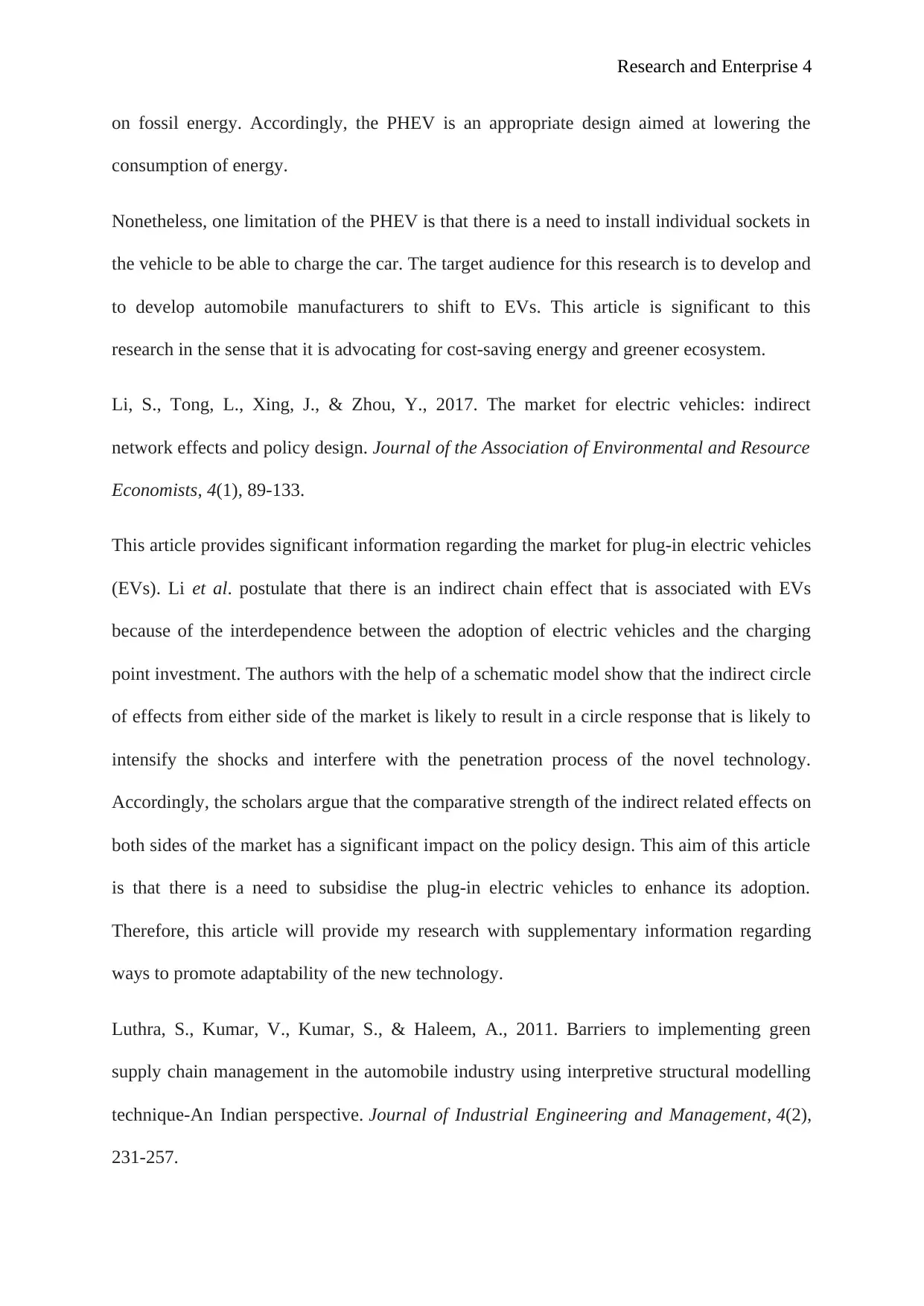
Research and Enterprise 4
on fossil energy. Accordingly, the PHEV is an appropriate design aimed at lowering the
consumption of energy.
Nonetheless, one limitation of the PHEV is that there is a need to install individual sockets in
the vehicle to be able to charge the car. The target audience for this research is to develop and
to develop automobile manufacturers to shift to EVs. This article is significant to this
research in the sense that it is advocating for cost-saving energy and greener ecosystem.
Li, S., Tong, L., Xing, J., & Zhou, Y., 2017. The market for electric vehicles: indirect
network effects and policy design. Journal of the Association of Environmental and Resource
Economists, 4(1), 89-133.
This article provides significant information regarding the market for plug-in electric vehicles
(EVs). Li et al. postulate that there is an indirect chain effect that is associated with EVs
because of the interdependence between the adoption of electric vehicles and the charging
point investment. The authors with the help of a schematic model show that the indirect circle
of effects from either side of the market is likely to result in a circle response that is likely to
intensify the shocks and interfere with the penetration process of the novel technology.
Accordingly, the scholars argue that the comparative strength of the indirect related effects on
both sides of the market has a significant impact on the policy design. This aim of this article
is that there is a need to subsidise the plug-in electric vehicles to enhance its adoption.
Therefore, this article will provide my research with supplementary information regarding
ways to promote adaptability of the new technology.
Luthra, S., Kumar, V., Kumar, S., & Haleem, A., 2011. Barriers to implementing green
supply chain management in the automobile industry using interpretive structural modelling
technique-An Indian perspective. Journal of Industrial Engineering and Management, 4(2),
231-257.
on fossil energy. Accordingly, the PHEV is an appropriate design aimed at lowering the
consumption of energy.
Nonetheless, one limitation of the PHEV is that there is a need to install individual sockets in
the vehicle to be able to charge the car. The target audience for this research is to develop and
to develop automobile manufacturers to shift to EVs. This article is significant to this
research in the sense that it is advocating for cost-saving energy and greener ecosystem.
Li, S., Tong, L., Xing, J., & Zhou, Y., 2017. The market for electric vehicles: indirect
network effects and policy design. Journal of the Association of Environmental and Resource
Economists, 4(1), 89-133.
This article provides significant information regarding the market for plug-in electric vehicles
(EVs). Li et al. postulate that there is an indirect chain effect that is associated with EVs
because of the interdependence between the adoption of electric vehicles and the charging
point investment. The authors with the help of a schematic model show that the indirect circle
of effects from either side of the market is likely to result in a circle response that is likely to
intensify the shocks and interfere with the penetration process of the novel technology.
Accordingly, the scholars argue that the comparative strength of the indirect related effects on
both sides of the market has a significant impact on the policy design. This aim of this article
is that there is a need to subsidise the plug-in electric vehicles to enhance its adoption.
Therefore, this article will provide my research with supplementary information regarding
ways to promote adaptability of the new technology.
Luthra, S., Kumar, V., Kumar, S., & Haleem, A., 2011. Barriers to implementing green
supply chain management in the automobile industry using interpretive structural modelling
technique-An Indian perspective. Journal of Industrial Engineering and Management, 4(2),
231-257.
Paraphrase This Document
Need a fresh take? Get an instant paraphrase of this document with our AI Paraphraser
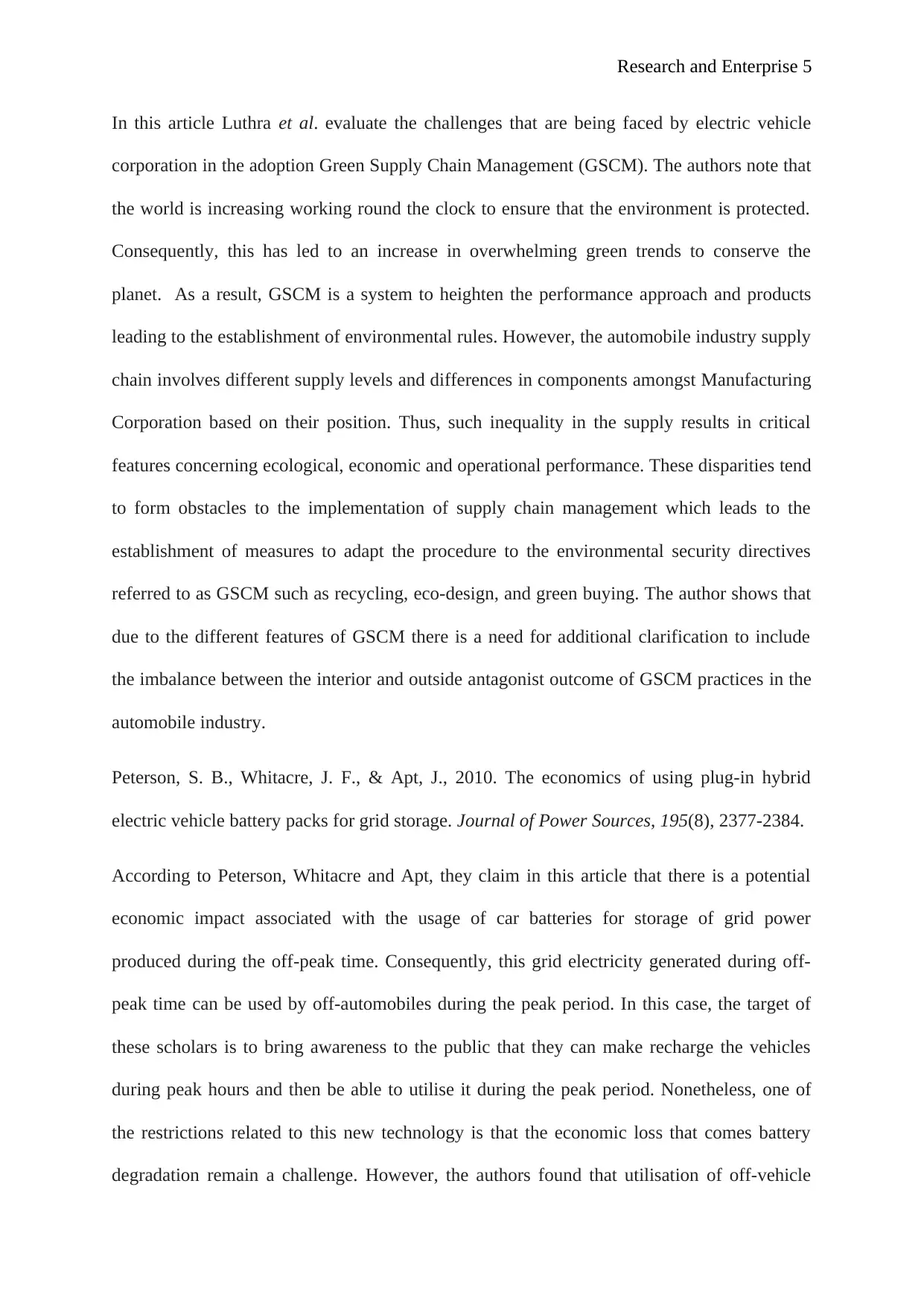
Research and Enterprise 5
In this article Luthra et al. evaluate the challenges that are being faced by electric vehicle
corporation in the adoption Green Supply Chain Management (GSCM). The authors note that
the world is increasing working round the clock to ensure that the environment is protected.
Consequently, this has led to an increase in overwhelming green trends to conserve the
planet. As a result, GSCM is a system to heighten the performance approach and products
leading to the establishment of environmental rules. However, the automobile industry supply
chain involves different supply levels and differences in components amongst Manufacturing
Corporation based on their position. Thus, such inequality in the supply results in critical
features concerning ecological, economic and operational performance. These disparities tend
to form obstacles to the implementation of supply chain management which leads to the
establishment of measures to adapt the procedure to the environmental security directives
referred to as GSCM such as recycling, eco-design, and green buying. The author shows that
due to the different features of GSCM there is a need for additional clarification to include
the imbalance between the interior and outside antagonist outcome of GSCM practices in the
automobile industry.
Peterson, S. B., Whitacre, J. F., & Apt, J., 2010. The economics of using plug-in hybrid
electric vehicle battery packs for grid storage. Journal of Power Sources, 195(8), 2377-2384.
According to Peterson, Whitacre and Apt, they claim in this article that there is a potential
economic impact associated with the usage of car batteries for storage of grid power
produced during the off-peak time. Consequently, this grid electricity generated during off-
peak time can be used by off-automobiles during the peak period. In this case, the target of
these scholars is to bring awareness to the public that they can make recharge the vehicles
during peak hours and then be able to utilise it during the peak period. Nonetheless, one of
the restrictions related to this new technology is that the economic loss that comes battery
degradation remain a challenge. However, the authors found that utilisation of off-vehicle
In this article Luthra et al. evaluate the challenges that are being faced by electric vehicle
corporation in the adoption Green Supply Chain Management (GSCM). The authors note that
the world is increasing working round the clock to ensure that the environment is protected.
Consequently, this has led to an increase in overwhelming green trends to conserve the
planet. As a result, GSCM is a system to heighten the performance approach and products
leading to the establishment of environmental rules. However, the automobile industry supply
chain involves different supply levels and differences in components amongst Manufacturing
Corporation based on their position. Thus, such inequality in the supply results in critical
features concerning ecological, economic and operational performance. These disparities tend
to form obstacles to the implementation of supply chain management which leads to the
establishment of measures to adapt the procedure to the environmental security directives
referred to as GSCM such as recycling, eco-design, and green buying. The author shows that
due to the different features of GSCM there is a need for additional clarification to include
the imbalance between the interior and outside antagonist outcome of GSCM practices in the
automobile industry.
Peterson, S. B., Whitacre, J. F., & Apt, J., 2010. The economics of using plug-in hybrid
electric vehicle battery packs for grid storage. Journal of Power Sources, 195(8), 2377-2384.
According to Peterson, Whitacre and Apt, they claim in this article that there is a potential
economic impact associated with the usage of car batteries for storage of grid power
produced during the off-peak time. Consequently, this grid electricity generated during off-
peak time can be used by off-automobiles during the peak period. In this case, the target of
these scholars is to bring awareness to the public that they can make recharge the vehicles
during peak hours and then be able to utilise it during the peak period. Nonetheless, one of
the restrictions related to this new technology is that the economic loss that comes battery
degradation remain a challenge. However, the authors found that utilisation of off-vehicle
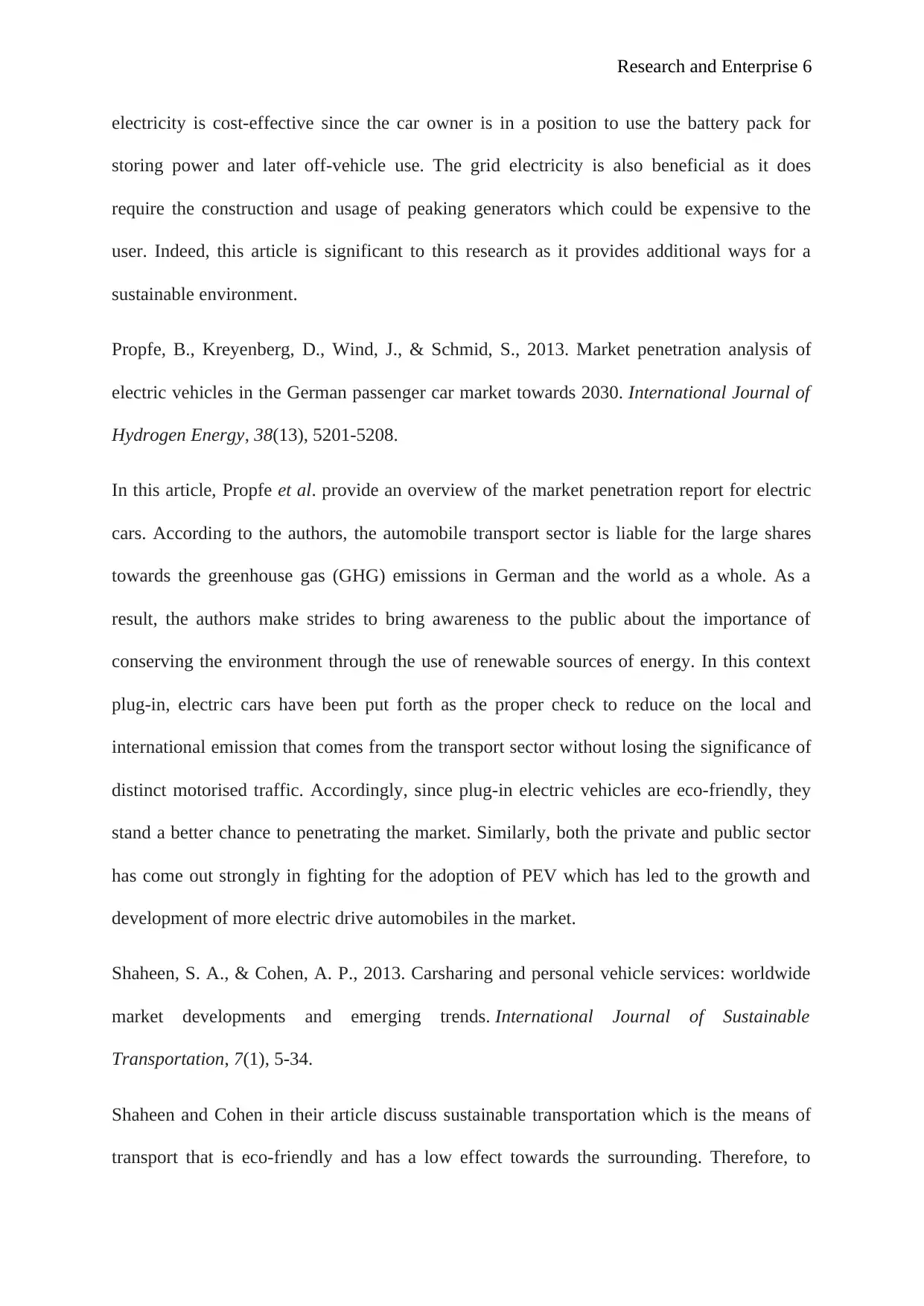
Research and Enterprise 6
electricity is cost-effective since the car owner is in a position to use the battery pack for
storing power and later off-vehicle use. The grid electricity is also beneficial as it does
require the construction and usage of peaking generators which could be expensive to the
user. Indeed, this article is significant to this research as it provides additional ways for a
sustainable environment.
Propfe, B., Kreyenberg, D., Wind, J., & Schmid, S., 2013. Market penetration analysis of
electric vehicles in the German passenger car market towards 2030. International Journal of
Hydrogen Energy, 38(13), 5201-5208.
In this article, Propfe et al. provide an overview of the market penetration report for electric
cars. According to the authors, the automobile transport sector is liable for the large shares
towards the greenhouse gas (GHG) emissions in German and the world as a whole. As a
result, the authors make strides to bring awareness to the public about the importance of
conserving the environment through the use of renewable sources of energy. In this context
plug-in, electric cars have been put forth as the proper check to reduce on the local and
international emission that comes from the transport sector without losing the significance of
distinct motorised traffic. Accordingly, since plug-in electric vehicles are eco-friendly, they
stand a better chance to penetrating the market. Similarly, both the private and public sector
has come out strongly in fighting for the adoption of PEV which has led to the growth and
development of more electric drive automobiles in the market.
Shaheen, S. A., & Cohen, A. P., 2013. Carsharing and personal vehicle services: worldwide
market developments and emerging trends. International Journal of Sustainable
Transportation, 7(1), 5-34.
Shaheen and Cohen in their article discuss sustainable transportation which is the means of
transport that is eco-friendly and has a low effect towards the surrounding. Therefore, to
electricity is cost-effective since the car owner is in a position to use the battery pack for
storing power and later off-vehicle use. The grid electricity is also beneficial as it does
require the construction and usage of peaking generators which could be expensive to the
user. Indeed, this article is significant to this research as it provides additional ways for a
sustainable environment.
Propfe, B., Kreyenberg, D., Wind, J., & Schmid, S., 2013. Market penetration analysis of
electric vehicles in the German passenger car market towards 2030. International Journal of
Hydrogen Energy, 38(13), 5201-5208.
In this article, Propfe et al. provide an overview of the market penetration report for electric
cars. According to the authors, the automobile transport sector is liable for the large shares
towards the greenhouse gas (GHG) emissions in German and the world as a whole. As a
result, the authors make strides to bring awareness to the public about the importance of
conserving the environment through the use of renewable sources of energy. In this context
plug-in, electric cars have been put forth as the proper check to reduce on the local and
international emission that comes from the transport sector without losing the significance of
distinct motorised traffic. Accordingly, since plug-in electric vehicles are eco-friendly, they
stand a better chance to penetrating the market. Similarly, both the private and public sector
has come out strongly in fighting for the adoption of PEV which has led to the growth and
development of more electric drive automobiles in the market.
Shaheen, S. A., & Cohen, A. P., 2013. Carsharing and personal vehicle services: worldwide
market developments and emerging trends. International Journal of Sustainable
Transportation, 7(1), 5-34.
Shaheen and Cohen in their article discuss sustainable transportation which is the means of
transport that is eco-friendly and has a low effect towards the surrounding. Therefore, to
⊘ This is a preview!⊘
Do you want full access?
Subscribe today to unlock all pages.

Trusted by 1+ million students worldwide
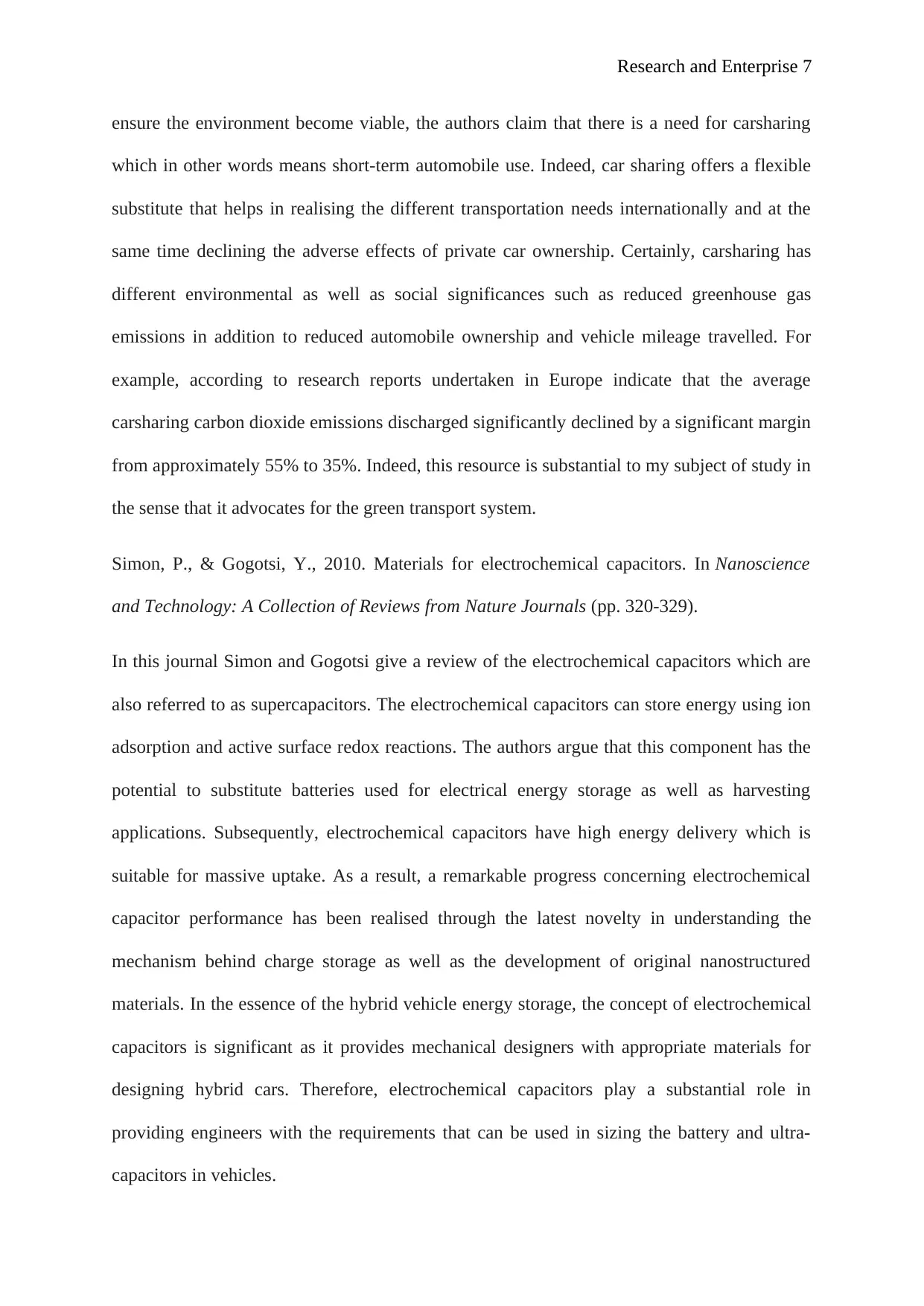
Research and Enterprise 7
ensure the environment become viable, the authors claim that there is a need for carsharing
which in other words means short-term automobile use. Indeed, car sharing offers a flexible
substitute that helps in realising the different transportation needs internationally and at the
same time declining the adverse effects of private car ownership. Certainly, carsharing has
different environmental as well as social significances such as reduced greenhouse gas
emissions in addition to reduced automobile ownership and vehicle mileage travelled. For
example, according to research reports undertaken in Europe indicate that the average
carsharing carbon dioxide emissions discharged significantly declined by a significant margin
from approximately 55% to 35%. Indeed, this resource is substantial to my subject of study in
the sense that it advocates for the green transport system.
Simon, P., & Gogotsi, Y., 2010. Materials for electrochemical capacitors. In Nanoscience
and Technology: A Collection of Reviews from Nature Journals (pp. 320-329).
In this journal Simon and Gogotsi give a review of the electrochemical capacitors which are
also referred to as supercapacitors. The electrochemical capacitors can store energy using ion
adsorption and active surface redox reactions. The authors argue that this component has the
potential to substitute batteries used for electrical energy storage as well as harvesting
applications. Subsequently, electrochemical capacitors have high energy delivery which is
suitable for massive uptake. As a result, a remarkable progress concerning electrochemical
capacitor performance has been realised through the latest novelty in understanding the
mechanism behind charge storage as well as the development of original nanostructured
materials. In the essence of the hybrid vehicle energy storage, the concept of electrochemical
capacitors is significant as it provides mechanical designers with appropriate materials for
designing hybrid cars. Therefore, electrochemical capacitors play a substantial role in
providing engineers with the requirements that can be used in sizing the battery and ultra-
capacitors in vehicles.
ensure the environment become viable, the authors claim that there is a need for carsharing
which in other words means short-term automobile use. Indeed, car sharing offers a flexible
substitute that helps in realising the different transportation needs internationally and at the
same time declining the adverse effects of private car ownership. Certainly, carsharing has
different environmental as well as social significances such as reduced greenhouse gas
emissions in addition to reduced automobile ownership and vehicle mileage travelled. For
example, according to research reports undertaken in Europe indicate that the average
carsharing carbon dioxide emissions discharged significantly declined by a significant margin
from approximately 55% to 35%. Indeed, this resource is substantial to my subject of study in
the sense that it advocates for the green transport system.
Simon, P., & Gogotsi, Y., 2010. Materials for electrochemical capacitors. In Nanoscience
and Technology: A Collection of Reviews from Nature Journals (pp. 320-329).
In this journal Simon and Gogotsi give a review of the electrochemical capacitors which are
also referred to as supercapacitors. The electrochemical capacitors can store energy using ion
adsorption and active surface redox reactions. The authors argue that this component has the
potential to substitute batteries used for electrical energy storage as well as harvesting
applications. Subsequently, electrochemical capacitors have high energy delivery which is
suitable for massive uptake. As a result, a remarkable progress concerning electrochemical
capacitor performance has been realised through the latest novelty in understanding the
mechanism behind charge storage as well as the development of original nanostructured
materials. In the essence of the hybrid vehicle energy storage, the concept of electrochemical
capacitors is significant as it provides mechanical designers with appropriate materials for
designing hybrid cars. Therefore, electrochemical capacitors play a substantial role in
providing engineers with the requirements that can be used in sizing the battery and ultra-
capacitors in vehicles.
Paraphrase This Document
Need a fresh take? Get an instant paraphrase of this document with our AI Paraphraser
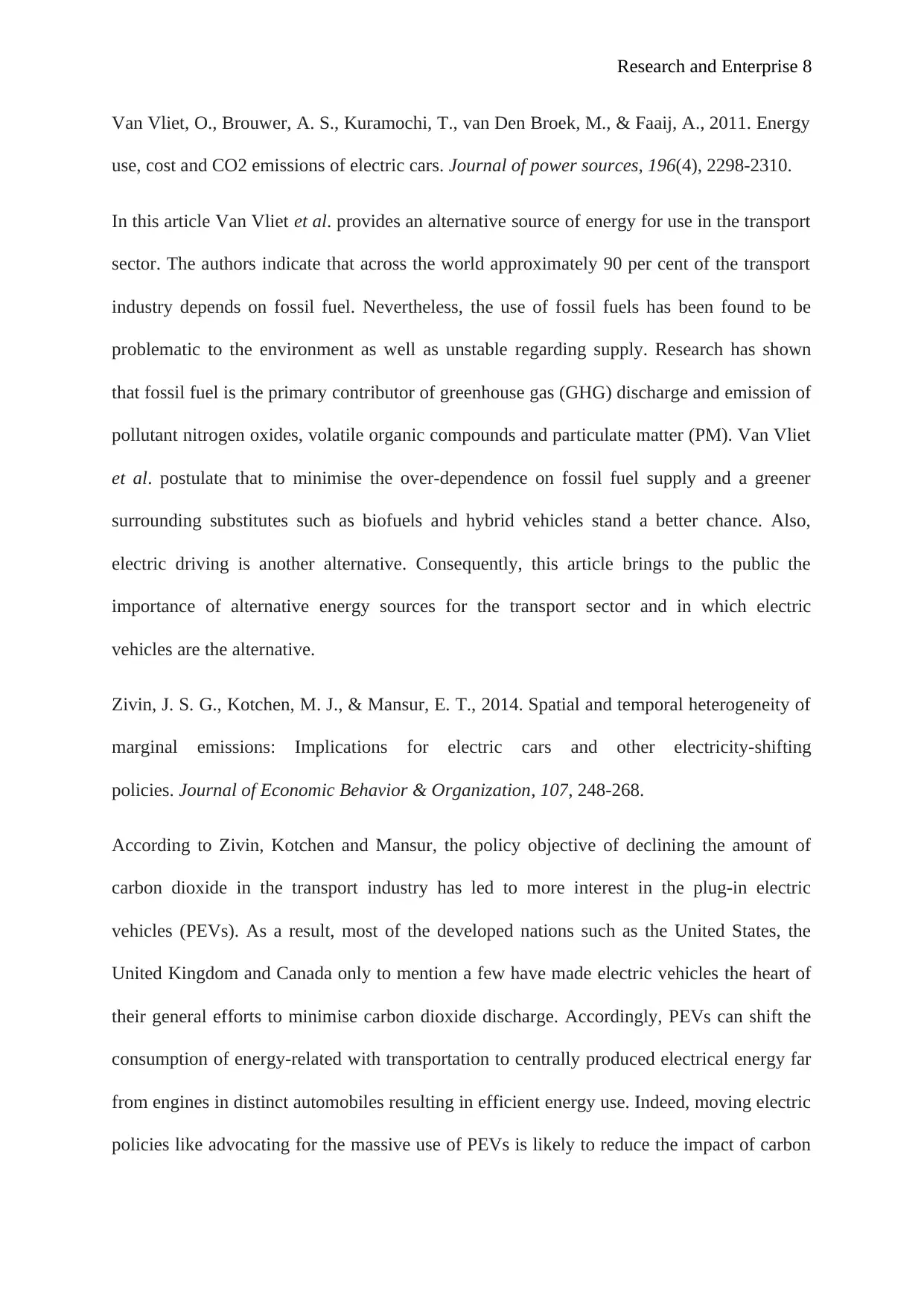
Research and Enterprise 8
Van Vliet, O., Brouwer, A. S., Kuramochi, T., van Den Broek, M., & Faaij, A., 2011. Energy
use, cost and CO2 emissions of electric cars. Journal of power sources, 196(4), 2298-2310.
In this article Van Vliet et al. provides an alternative source of energy for use in the transport
sector. The authors indicate that across the world approximately 90 per cent of the transport
industry depends on fossil fuel. Nevertheless, the use of fossil fuels has been found to be
problematic to the environment as well as unstable regarding supply. Research has shown
that fossil fuel is the primary contributor of greenhouse gas (GHG) discharge and emission of
pollutant nitrogen oxides, volatile organic compounds and particulate matter (PM). Van Vliet
et al. postulate that to minimise the over-dependence on fossil fuel supply and a greener
surrounding substitutes such as biofuels and hybrid vehicles stand a better chance. Also,
electric driving is another alternative. Consequently, this article brings to the public the
importance of alternative energy sources for the transport sector and in which electric
vehicles are the alternative.
Zivin, J. S. G., Kotchen, M. J., & Mansur, E. T., 2014. Spatial and temporal heterogeneity of
marginal emissions: Implications for electric cars and other electricity-shifting
policies. Journal of Economic Behavior & Organization, 107, 248-268.
According to Zivin, Kotchen and Mansur, the policy objective of declining the amount of
carbon dioxide in the transport industry has led to more interest in the plug-in electric
vehicles (PEVs). As a result, most of the developed nations such as the United States, the
United Kingdom and Canada only to mention a few have made electric vehicles the heart of
their general efforts to minimise carbon dioxide discharge. Accordingly, PEVs can shift the
consumption of energy-related with transportation to centrally produced electrical energy far
from engines in distinct automobiles resulting in efficient energy use. Indeed, moving electric
policies like advocating for the massive use of PEVs is likely to reduce the impact of carbon
Van Vliet, O., Brouwer, A. S., Kuramochi, T., van Den Broek, M., & Faaij, A., 2011. Energy
use, cost and CO2 emissions of electric cars. Journal of power sources, 196(4), 2298-2310.
In this article Van Vliet et al. provides an alternative source of energy for use in the transport
sector. The authors indicate that across the world approximately 90 per cent of the transport
industry depends on fossil fuel. Nevertheless, the use of fossil fuels has been found to be
problematic to the environment as well as unstable regarding supply. Research has shown
that fossil fuel is the primary contributor of greenhouse gas (GHG) discharge and emission of
pollutant nitrogen oxides, volatile organic compounds and particulate matter (PM). Van Vliet
et al. postulate that to minimise the over-dependence on fossil fuel supply and a greener
surrounding substitutes such as biofuels and hybrid vehicles stand a better chance. Also,
electric driving is another alternative. Consequently, this article brings to the public the
importance of alternative energy sources for the transport sector and in which electric
vehicles are the alternative.
Zivin, J. S. G., Kotchen, M. J., & Mansur, E. T., 2014. Spatial and temporal heterogeneity of
marginal emissions: Implications for electric cars and other electricity-shifting
policies. Journal of Economic Behavior & Organization, 107, 248-268.
According to Zivin, Kotchen and Mansur, the policy objective of declining the amount of
carbon dioxide in the transport industry has led to more interest in the plug-in electric
vehicles (PEVs). As a result, most of the developed nations such as the United States, the
United Kingdom and Canada only to mention a few have made electric vehicles the heart of
their general efforts to minimise carbon dioxide discharge. Accordingly, PEVs can shift the
consumption of energy-related with transportation to centrally produced electrical energy far
from engines in distinct automobiles resulting in efficient energy use. Indeed, moving electric
policies like advocating for the massive use of PEVs is likely to reduce the impact of carbon

Research and Enterprise 9
dioxide emissions as compared to driving fuel-efficient hybrid cars. However, the lack of
comprehensive and transparent Life Cycle Inventory is a drawback in LCA. The most
important aspect is that research concerning the production of energy and LCA of energy
systems have been consulted to gain a better understanding of the modelling alternative to be
applied in electric vehicles LCAs.
dioxide emissions as compared to driving fuel-efficient hybrid cars. However, the lack of
comprehensive and transparent Life Cycle Inventory is a drawback in LCA. The most
important aspect is that research concerning the production of energy and LCA of energy
systems have been consulted to gain a better understanding of the modelling alternative to be
applied in electric vehicles LCAs.
⊘ This is a preview!⊘
Do you want full access?
Subscribe today to unlock all pages.

Trusted by 1+ million students worldwide

Research and Enterprise 10
Bibliography
Adnan, N., Nordin, S.M., Rahman, I., Vasant, P.M. and Noor, A., 2017. A comprehensive
review of theoretical framework‐based electric vehicle consumer adoption research.
International Journal of Energy Research, 41(3), pp.317-335.
Baptista, P., Tomás, M., & Silva, C., 2010. Plug-in hybrid fuel cell vehicles market
penetration scenarios. International Journal of Hydrogen Energy, 35(18), 10024-10030.
Li, S., Tong, L., Xing, J., & Zhou, Y., 2017. The market for electric vehicles: indirect
network effects and policy design. Journal of the Association of Environmental and Resource
Economists, 4(1), 89-133.
Luthra, S., Kumar, V., Kumar, S., & Haleem, A., 2011. Barriers to implementing green
supply chain management in the automobile industry using interpretive structural modelling
technique-An Indian perspective. Journal of Industrial Engineering and Management, 4(2),
231-257.
Peterson, S. B., Whitacre, J. F., & Apt, J., 2010. The economics of using plug-in hybrid
electric vehicle battery packs for grid storage. Journal of Power Sources, 195(8), 2377-2384.
Propfe, B., Kreyenberg, D., Wind, J., & Schmid, S., 2013. Market penetration analysis of
electric vehicles in the German passenger car market towards 2030. International Journal of
Hydrogen Energy, 38(13), 5201-5208.
Shaheen, S. A., & Cohen, A. P., 2013. Carsharing and personal vehicle services: worldwide
market developments and emerging trends. International Journal of Sustainable
Transportation, 7(1), 5-34.
Simon, P., & Gogotsi, Y., 2010. Materials for electrochemical capacitors. In Nanoscience
and Technology: A Collection of Reviews from Nature Journals (pp. 320-329).
Bibliography
Adnan, N., Nordin, S.M., Rahman, I., Vasant, P.M. and Noor, A., 2017. A comprehensive
review of theoretical framework‐based electric vehicle consumer adoption research.
International Journal of Energy Research, 41(3), pp.317-335.
Baptista, P., Tomás, M., & Silva, C., 2010. Plug-in hybrid fuel cell vehicles market
penetration scenarios. International Journal of Hydrogen Energy, 35(18), 10024-10030.
Li, S., Tong, L., Xing, J., & Zhou, Y., 2017. The market for electric vehicles: indirect
network effects and policy design. Journal of the Association of Environmental and Resource
Economists, 4(1), 89-133.
Luthra, S., Kumar, V., Kumar, S., & Haleem, A., 2011. Barriers to implementing green
supply chain management in the automobile industry using interpretive structural modelling
technique-An Indian perspective. Journal of Industrial Engineering and Management, 4(2),
231-257.
Peterson, S. B., Whitacre, J. F., & Apt, J., 2010. The economics of using plug-in hybrid
electric vehicle battery packs for grid storage. Journal of Power Sources, 195(8), 2377-2384.
Propfe, B., Kreyenberg, D., Wind, J., & Schmid, S., 2013. Market penetration analysis of
electric vehicles in the German passenger car market towards 2030. International Journal of
Hydrogen Energy, 38(13), 5201-5208.
Shaheen, S. A., & Cohen, A. P., 2013. Carsharing and personal vehicle services: worldwide
market developments and emerging trends. International Journal of Sustainable
Transportation, 7(1), 5-34.
Simon, P., & Gogotsi, Y., 2010. Materials for electrochemical capacitors. In Nanoscience
and Technology: A Collection of Reviews from Nature Journals (pp. 320-329).
Paraphrase This Document
Need a fresh take? Get an instant paraphrase of this document with our AI Paraphraser

Research and Enterprise 11
Van Vliet, O., Brouwer, A. S., Kuramochi, T., van Den Broek, M., & Faaij, A., 2011. Energy
use, cost and CO2 emissions of electric cars. Journal of power sources, 196(4), 2298-2310.
Zivin, J. S. G., Kotchen, M. J., & Mansur, E. T., 2014. Spatial and temporal heterogeneity of
marginal emissions: Implications for electric cars and other electricity-shifting
policies. Journal of Economic Behavior & Organization, 107, 248-268.
Van Vliet, O., Brouwer, A. S., Kuramochi, T., van Den Broek, M., & Faaij, A., 2011. Energy
use, cost and CO2 emissions of electric cars. Journal of power sources, 196(4), 2298-2310.
Zivin, J. S. G., Kotchen, M. J., & Mansur, E. T., 2014. Spatial and temporal heterogeneity of
marginal emissions: Implications for electric cars and other electricity-shifting
policies. Journal of Economic Behavior & Organization, 107, 248-268.
1 out of 11
Related Documents
Your All-in-One AI-Powered Toolkit for Academic Success.
+13062052269
info@desklib.com
Available 24*7 on WhatsApp / Email
![[object Object]](/_next/static/media/star-bottom.7253800d.svg)
Unlock your academic potential
© 2024 | Zucol Services PVT LTD | All rights reserved.





